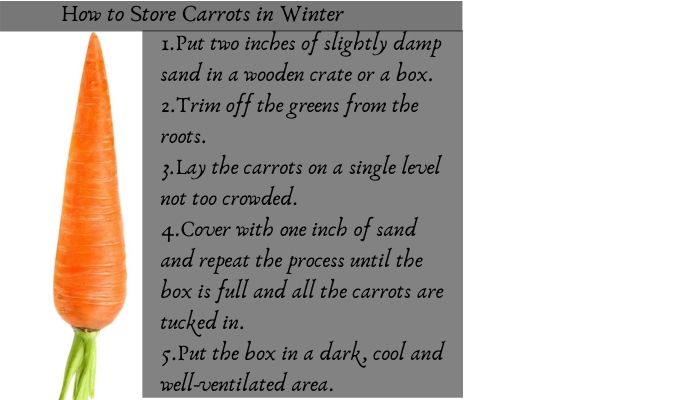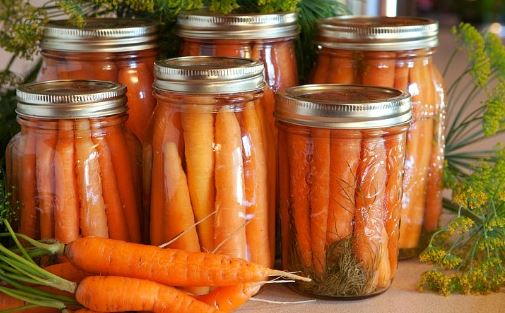Carrots can stay fresh for as long as 12 months depending on the method of storage. In order to retain their freshness and keep them crispy that long you need to minimize the moisture that they tend to lose during storage.
Store carrots in the refrigerator submerged in a jar of water to keep them moisturized for 4 weeks ensuring to change the water after every 3-4 days. You can also put them in a perforated plastic bag and store them in your pantry if you intend to use them in 5 days’ time.

Best ways to store carrots
Wilting occurs when carrots start to get dehydrated, in order to prevent this you have to trim off the green tops as soon as possible since they tend to draw moisture from the root.
Whether you plan to store carrots in the refrigerator or not, you should always keep them away from ethylene-producing fruits like apples, pears, and ripe bananas which speeds up the ripening process leaving your carrot limp.
1. Storing carrots in the pantry
Carrots can stay in the pantry for as long as 3-5 days. What you want to do is to choose that place in your pantry that remains cool for long. However, that may not be enough since carrots may still lose moisture over time. To prevent this, use plastic bags to help them retain moisture and remain fresh for long.
Here’s how to keep carrots fresh in your pantry:
- Scrape off excess soil from the carrots. As washing increases moisture which speeds up decay.
- Trim off the green tops from the roots.
- Pack the carrots in a plastic bag since they tend to go limp once exposed to air.
- Put the carrots in the coolest part of the pantry.
2. Refrigeration
Refrigeration prolongs the life span of a carrot by making it stay crunchy and firm for up to 4 weeks. This can be done by either using a plastic bag or a water-filled bowl as illustrated below.
Using plastic bags
Plastic bags help carrots retain moisture for longer and prevent the entry of air that can make carrots go limp. In order to prevent this, you want to seal them in plastic bags and keep them air-tight.
Here’s how to do it:
- Cut off the green tops from the roots
- Tightly seal the carrots in a plastic bag.
- Place the plastic bag with your carrots in the coolest part of the refrigerator.
Storing in water

Alternatively, you can opt to use plain water instead of the plastic bags in the procedure above. Carrots stay cool and absorb water, remaining turgid for a long time.
Here’s how to store carrots in the fridge using water:
- Trim off the green tops from the roots.
- Put the carrots in a water-filled bowl and cover it tightly with a plastic bag or lid.
- Put the bowl in the fridge and change the water every two days.
3. Freezing
Just like most vegetables, carrots need to be blanched before putting them in the freezer. Blanching stops enzymatic activity that decays vegetables and also helps the carrots to retain their texture, color, and flavor. This is how you go about it:
- Trim off the green tops from the roots.
- Peel and wash the carrots thoroughly.
- Slice or dice to the required size.
- In a pot of boiling water, put the carrots in and let them boil for 3 minutes
- Drain them and put them in ice-cold water to stop the cooking process
- Drain and let them dry
- Spread the carrots on a baking tray in a single layer ensuring they don’t touch each other
- Freeze for 2 hours or until they are completely frozen
- Transfer the frozen carrots in a freezer bag
- Seal the bag ensuring to remove any air inside
- Put them in the freezer
Properly stored, frozen carrots will maintain the best quality for up to 12 months in a freezer.
4. Storing carrots in sand
This method works best during winter. All you need is sand, little water to dampen the sand, a box, and fresh carrots then live the rest to the cold weather.
Storing carrots in sand prolongs their lifespan for up to 6 months using the following steps:
- Put two inches of slightly damp sand in a wooden crate or a box.
- Trim off the greens from the roots.
- Lay the carrots on a single level not too crowded.
- Lastly, cover with one inch of sand and repeat the process until the box is full and all the carrots are tucked in.
- Put the box in a dark, cool and well-ventilated area.
How to tell if carrots are spoiled
Just like any other vegetable, carrots will go bad at some point. This could be due to high temperatures, dehydration or exposure to excess moisture. Carrots that are spoiling may change in texture, appearance, and taste but that doesn’t mean they are unsafe to eat until they become mushy and slimy. Here are 4 signs of carrots that have gone bad:
1. Soft and easy to bend
It’s easy to tell when a carrot is going bad by simply touching and feeling its texture. A spoiling carrot will feel soft and easy to bend. The carrot may not be crunchy and great in taste but it will still be safe to eat.
2. White blush
Some carrots will appear to have tiny white dots usually caused by dehydration. This doesn’t mean that the carrots are unsafe to consume but should be eaten as soon as possible.
3. Black sports on carrots
Your carrot may also appear to have black spots which are normally caused by a fungus due to high temperatures. All you need to do is cut off the dark sports since the rest of the carrot is safe to eat.
4. Slimy and mushy
Carrots may become slimy and mushy due to excess moisture. Get rid of such carrots as they can lead to serious digestive issues.
Tips on how to choose fresh carrots
when shopping for carrots:
- Go for carrots with a deep orange color. The deeper the orange color, the more beta-carotene is present in the carrot, and the healthier it is.
- Choose carrots with feathery and brightly colored green tops. If the carrots do not have their green tops attached, look at the stem end and ensure it is not darkly colored as this is a sign of age.
- Choose carrots with a larger diameter as they tend to be sweeter. This is because they have a larger core where sugars are concentrated.
